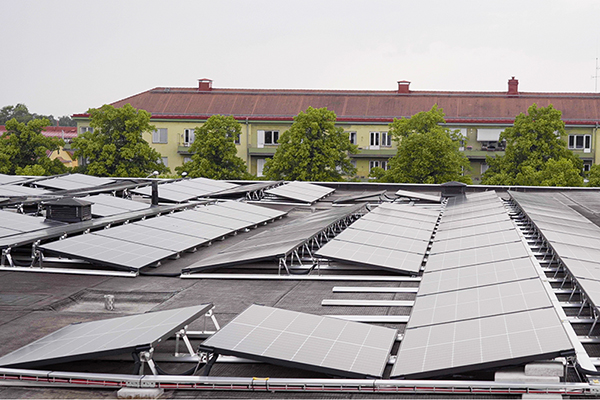The University commissioned a climate inventory to calculate the amount of greenhouse gas emissions generated by the University’s activities over a year and to estimate how the breakdown of emissions between different activities.
“First of all, of course, we must analyse the results. The next step will be to work out an environmental plan that will help us reduce our carbon footprint without losing our focus on the quality of our research and education,” says Anders Hagfeldt, Vice-Chancellor of Uppsala University.
Results of the climate inventory
The climate inventory, carried out by an external consultancy firm on behalf of Uppsala University, estimated that the University’s activities generate greenhouse gas emissions corresponding to just over 50,000 tonnes of carbon dioxide in one year (2019). This breaks down to approximately 8 tonnes of CO2 per full-time equivalent employee.
The three biggest sources of emissions are business travel, buildings and purchases of goods.
Compared to similar climate inventories carried out by other higher education institutions, Uppsala University’s emissions are at approximately the same level as Stockholm University and the University of Gothenburg.
“We thought that our emissions would be at the same level as other Swedish higher education institutions, so our inventory confirms this. Now we also have a good picture of how the emissions from our University relate to different parts of its activities,” says Karolina Kjellberg, Environment Manager. “This is important knowledge for our work in this area in the future. All higher education institutions are facing the same huge challenge: emissions are too high and need to be cut by at least half by 2030.”
In 2017, the Swedish Riksdag adopted a climate policy framework which stipulates that Sweden will not have any net greenhouse gas emissions by 2045 – net zero in other words. The Paris Agreement in turn aims to ensure that the global temperature increase does not exceed 1.5 degrees. To keep under this limit, the IPCC has stated that net emissions must be halved by 2030 and then reduced to zero by 2050.
One aim of the climate inventory was to identify the biggest sources of emissions in order to then see what measures can and need to be taken to reduce them. In fact, the Riksdag’s climate framework and international agreements mean that all activities need to adapt what they do in order to achieve these goals.
Biggest sources of emissions
Business travel accounts for about 36 per cent of emissions, of which air travel accounts for the majority, at about 90 per cent. In the inventory, a comparison was made between 2019 and 2020 in order to get an idea of how the pandemic has affected business travel. Emissions in fact decreased by 79 per cent in 2020 compared to 2019.
Buildings account for about 33 per cent of emissions and the biggest source of emissions for buildings is energy use.
Purchases of goods account for about 19 per cent of emissions. These emissions mainly come from the purchase of research equipment for labs, chemicals, pharmaceuticals, and lab equipment.
New environmental plan
Now that the climate inventory is complete, work on a new, revised environmental plan for the University will take over. A working group is currently writing a draft for a new environmental plan for the University.
The aim is to have an environmental plan with a 2–3 year horizon. In addition, the environmental plan will cover more issues than just greenhouse gas emissions, such as a non-toxic environment and biodiversity. The environmental plan will attempt to cover all the environmental issues of the University as a whole.
The new environmental plan will build on efforts already made or ongoing. For example, energy efficiency improvements in the University’s premises led to a seven per cent reduction in energy use in 2020. A pilot project at Campus Engelska parken has led to a 12 per cent reduction in energy use. Other examples of steps taken are:
- Environmental requirements in procurement
- Cleaning services use plastic bags made of recycled plastic
- Solar panels on the University’s buildings
- Rail travel grants for Erasmus students
- Sustainability-assessed building materials for major conversions and extensions
- Measures to increase biodiversity on campus.
Focus on sustainable development
“Another main focus will be to make a clear commitment to sustainable development in both research and education,” says Vice-Chancellor Anders Hagfeldt. At the Deans Day hosted by the University Management Team, we discussed how to create the necessary conditions for interdisciplinary competitive research. This conversation will continue with the heads of department so that we can harness the commitment that exists throughout the University.”
